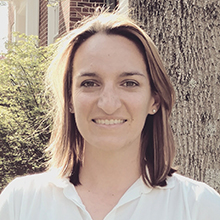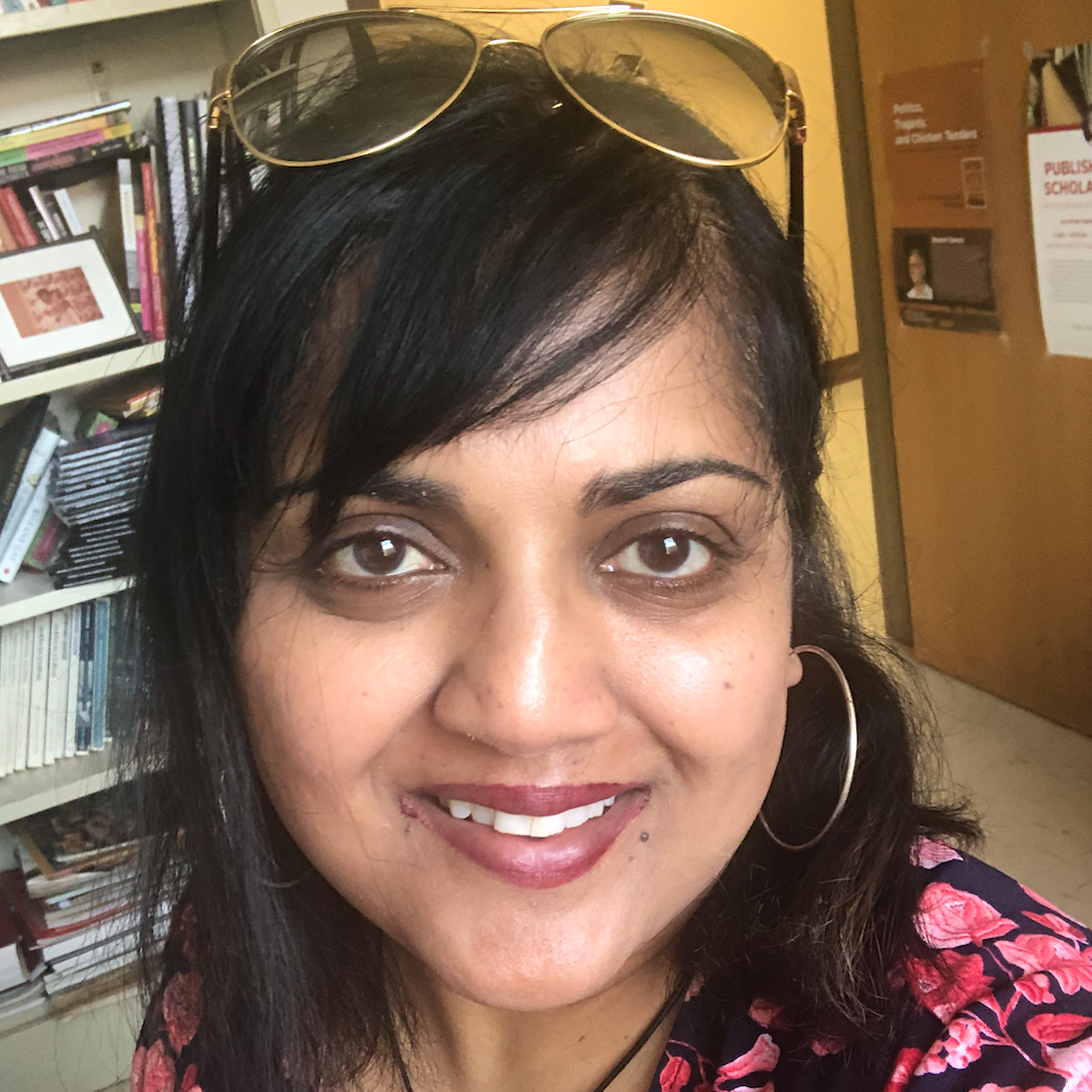Miami Professors Discuss Their New Books and the Writing Process

By Chris Murphy
When I met Annie Dell’Aria, assistant professor of art history, and Anita Mannur, associate professor of English, for a Zoom interview to talk about their forthcoming books I found them, naturally, immersed in matters of those books.
Dell’Aria had just been proofreading a hard copy of the manuscript for The Moving Image as Public Art: Sidewalk Spectators and Modes of Enchantment. Due out in June 2021 with Palgrave MacMillan, this will be Dell’Aria’s first book. Mannur, meanwhile, was anxiously awaiting final word from Duke University Press’s editorial board on an approval vote for her third book, Intimate Eating Publics: Food and Forms and Radical Belonging. (Happily, a week after our interview the board approved a final contract for Mannur’s book; it’s likely to be released in 2022).
The two were generous enough to talk at length about their paths to publication, which were made with plenty of hard work and some good fortune, too, in finding just the right editors and presses for their projects. They also discussed the writing practices that have enabled them to write around the many demands of their jobs. After all, it was by embracing writing as a process and sticking to a regular writing routine, especially during these times of pandemic, that Dell’Aria and Mannur managed to prepare manuscripts for publication in the first place.
Embracing Writing as a Process
“It’s a mess,” Dell’Aria said of her first attempts to write anything. Her early drafts bear little resemblance to the polished pages Palgrave MacMilllan will soon print in The Moving Image as Public Art. Instead, there’s a fair amount of highlighted text. Some red text. Notes to self to add support from certain scholars and fact check certain claims. Bullet points outlining the next few movements of the piece. In a pedagogical practice we’d very much endorse at the Howe Center for Writing Excellence (HCWE), Dell’Aria even shows examples of these “zero drafts” to her students to help them grasp that, yes, even publishing scholars have to start with the humble beginnings of the blank page.
This practice of getting words down without the pressure of making them perfect began for Dell’Aria in graduate school. There she read How To Write Your Dissertation in Fifteen Minutes A Day. While the book may suffer for the unrealistic premise of its title, Dell’Aria said, its lessons can still help people reevaluate their relationship with writing. She struggles at times, for example, with procrastination and self-doubt. By simply putting pen to paper (or fingers to keyboard), Dell’Aria has taken meaningful steps forward on writing projects.
Mannur also used the word “mess” while describing her process. She knows it’s not easy to get started on a draft, so she prefers to work her way gradually into one. A strategy she uses, and also encourages her students to use, is to identify three quotes from your sources and see what connects them. Mannur also doesn’t tend to think linearly. Rather than focus on fleshing out her analysis and argument, she might first focus on descriptive writing, like conveying a scene in a film. She’ll proceed in crafting the various components of the piece until she feels there’s enough “mess” to work with. She’ll then return to the beginning and settle in, writing everything cohesively.
Establishing a Writing Routine
“I’ve had a lot of issues in the past with just sticking to [a writing project],” Mannur said. “Because work just takes over.” To guard against this, she tries to always set Friday mornings aside as dedicated time for writing. It’s a routine Mannur started during her first tenure-track job, writing at the local Barnes & Noble’s Starbucks Cafe, and continues here at Miami by frequenting the HCWE’s open Writing Hours. Dell’Aria, too, says that progress on her writing projects has reliably come from getting her schedule “under control.” It’s one thing to look for small chunks of time to write—a little in the morning, a little over lunch—but both Mannur and Dell’Aria have found they need extended time.
As she works, Mannur likes to keep her writing goals manageable. This was especially important in finishing her latest book manuscript. When she felt she needed a deadline extension last year, her editor told her, wisely, “I’d rather have a good book than a rushed book.” Mannur also doesn’t like to set hard and fast goals every time she writes. Following the advice of her graduate school mentor, David Lenson, she prefers to stop writing in medias res. By resisting the lure to arrive at a logical place for ending, she’s able to pick up more easily the next time.
For Mannur and Dell’Aria, the writing routine extends beyond their desks and laptops. They keep their minds with their writing and are prepared to capture wherever their thinking goes. As a graduate student in New York City, Dell’Aria would use the Evernote app for logging ideas that sprung while walking from the subway to the library. She finds such “transitional spaces” even now, like walking from her car to her office, useful for thinking about her writing. Mannur tends to think most clearly late at night, just before bed. For this reason, she likes the model offered by Sei Shōnagon’s The Pillow Book—the writer tapping into the mind around sleep. She’ll record voice memos on her iPhone, sometimes finding she can arrive at an elusive turn of phrase or a new idea or direction for a piece. The memos may often be unusable, but Mannur enjoys waking up each morning to find out “what nonsensical voice memo [she has] today.”
The Path to Publication
Dell’Aria traces her book’s roots back to a 2017 presentation she gave at the College Art Association in Manhattan. After the presentation, an editor from Palgrave MacMillan approached Dell'Aria expressing interest in her work. She didn’t consider the material, derived from her PhD dissertation, book-ready yet, but a vital connection with a publisher had been made.
Dell’Aria kept writing and developing her ideas. In the meantime, Palgrave MacMillan established a new book series: Experimental Film and Artists’ Moving Image. Dell’Aria’s manuscript in-progress and the new series aligned perfectly. In early 2019, she sent a proposal and a few sample chapters to the series editor, which were then sent out to peer reviewers and received a positive response. The reviewers also provided helpful feedback on Dell’Aria’s theoretical framework and the scholars she was citing. Her manuscript was accepted in early October. Now she’s on the exciting, but also exacting, last steps of proofreading, making final revisions, and acquiring image rights.
Mannur can link this latest book all the way back to 2009 when she met Courtney Berger, who is now her editor at Duke University Press. The two connected then over a shared interest in food. Mannur had just published her second book. She wasn’t ready to talk about another one. Instead, the two would meet over coffee at conferences to simply catch up and chat. “Talk to editors like they’re people,” Mannur tells her graduate students. “Not just someone who can do something for you.”
Looking back, Mannur can see how Berger was helping her think through the ideas for her new project during those informal meetings. Eventually, Mannur wrote a proposal for what would become Intimate Eating Publics. Duke accepted that proposal quickly, and Mannur began working on the book in earnest in 2018. The writing mostly entailed adapting various conference papers she had delivered in recent years. She focused on taking out the conversational aspects and engaging more with the work of other scholars on the topic. Now that Duke has approved her manuscript, she’ll soon be joining Dell’Aria in the final stages of the publication process.
Writing Through Challenging Times
It’s worth noting that as Mannur and Dell’Aria worked to finish their book manuscripts they were also living, and teaching, through the COVID-19 pandemic.
“I felt like I was in Waiting For Godot,” Mannur said of last Spring. The timeline for a return to normalcy kept being pushed back further and further. And here we are now, some nine months later, still waiting for normalcy.
These times of uncertainty and social distancing weigh on both Dell’Aria and Mannur. Both have also found, though, that being mostly homebound helps them focus on their writing tasks. For Mannur, writing has become a welcome companion. Every writing session brings the possibility of a new experience. There’s an excitement, and a sense of purpose, in that.
This pandemic reminds us all that the perfect conditions for writing, like Godot, never do quite arrive. Rather than wait for them, Mannur and Dell’Aria got to work.

Dr. Annie Dell'Aria is an assistant professor of art history at Miami University. Her research interests concern the intersection of contemporary art, screen media, and public space. You can find her writings in Afterimage: The Journal of Media Arts and Cultural Criticism, International Journal of Performance Arts and Digital Media, Moving Image Review and Art Journal (MIRAJ), Public Art Dialogue, and other venues. Her first book, The Moving Image as Public Art: Sidewalk Spectators and Modes of Enchantment, is forthcoming from Palgrave MacMillan.

Dr. Anita Mannur is an associate professor of English at Miami University. Her teaching and research interests include Asian American literature and culture, South Asian diasporic literature and culture, transnational and diaspora studies, food studies, and gender studies. She is the author of Culinary Fictions: Food in South Asian Diasporic Culture (2010) and co-editor of Theorizing Diaspora (2004) and Eating Asian America: A Reader (2013). Her third book, Intimate Eating Publics: Food and Forms and Radical Belonging, is forthcoming from Duke University Press.
Looking to put regular writing time on your calendar? The HCWE offers open Writing Hours twice-weekly during the Fall and Spring Semesters plus 2 all-day Writing Retreats each semester (and a 4-day Retreat over J-Term). All Miami faculty and graduate student writers are welcome.

